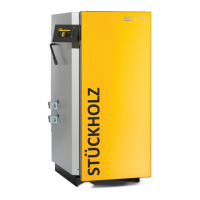12 www.eta.co.at
Safety devices Safety
the boiler against overheating if the pump fails. The
minimum pressure in the cold water pipe must be 2 bar
and the temperature must not exceed 15 °C.
Fig. 3-2: Thermal emergency cooling valve
Only thermal emergency cooling valves that
correspond to the standard DIN EN 14597 (or
comparable standards) may be installed. They must
activate at 100 °C and have a flow rate of at least
2.0 m³/h. The clear width of the cold water supply and
outlet may not fall below the nominal diameter of the
safety heat exchanger.
The cold water supply must be connected to the upper
connector of the safety heat exchanger; the lower
connector serves as an outlet to the sewer. To prevent
the supply line from being shut off accidentally, remove
the levers from ball valves or the hand wheels from
valves and hang them there with a piece of wire.
Fig. 3-3: Installation on the boiler
1 Cold water connection
2 Isolating valve; remove hand wheel
3Strainer
4 Thermal emergency cooling valve
5 Visible outlet to sewer
The outlet must have an easily visible flow path so mal-
functions can be recognised. Direct the discharged
water to the sewer via a siphon funnel or at least with
a pipe into the ground so that nobody can be scalded
if the valve is activated.
Even for cold water coming from a domestic well with
its own pump, a thermal emergency cooling valve must
be installed on the boiler. With a generously
dimensioned air vessel, enough water for cooling will
come even if there is a power failure. If the power
supply is very uncertain, a dedicated air vessel for the
thermal emergency cooling valve is required.
Safety shutdown by safety temperature limiter
For additional safety against boiler overheating, a
safety temperature limiter is built into the boiler. When
a boiler temperature of 105°C (tolerance 100 to 106°C)
is reached, it blocks the draught fan so that it can no
longer be switched on. When the boiler temperature
decreases below 70°C again, the safety temperature
limiter can be manually released for a restart of the
boiler.
Installing a safety valve against overpressure
A safety valve with 3 bar opening pressure must be
installed on the boiler. Every heat producer in a heating
system must be protected by at least one safety valve
against pressure exceeding the maximum permissible
operating pressure (see EN 12828). These valves
must be designed such as to ensure the maximum
permissible operating pressure that can arise in the
heating system or parts thereof. The safety valve must
be situated in the boiler room and be easily accessible.
Fig. 3-4: Safety valve
DANGER!
Do not install any shut-off valves, strainers or such like
between the boiler and the safety valve.
The connection size of the safety valve is determined
on the basis of the heating system's maximum heating
capacity, as shown in the table.
Valve size
a
Nominal diameter (DN)
Maximum heating ca-
pacity (kW)
15 (G ½) 50

